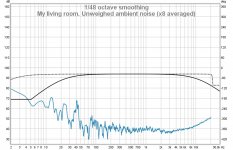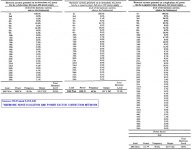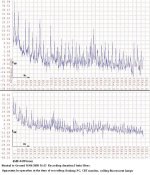The key is the noise distribution. The s/n is specified, as I mentioned, over 20-20k unweighted. Noise limitation is the input tube. So, you can draw the appropriate conclusion. For comparison purposes, the JC-1 measured the same way shows -73.3dB/ref 2.83V.
Oh no. When Atkinson says "unweighted, wideband signal/noise ratio (ref. 1W into 8 ohms)", it is not 20Hz - 20kHz, but AP wideband, which would be about 80kHz BW at least. In this test, he uses only wideband unweighted and A weighted (= A over 20kHz). In another tests he uses also 20Hz - 20kHz unweighted, but not in this test.
http://www.stereophile.com/content/parasound-halo-jc-1-monoblock-power-amplifier-measurements
He gives A-weighted s/n as 87.8dB ref 2.83V. For comparison, Atkinson specs 86.6dB for the Pass XA60.5, unweighted and "restricted to the audio band." So the JC-1 isn't too far off. These are all very good, quiet power amps. If one wanted to go full-out on noise, the input stage would be the target, but all these amps are more than good enough in that respect.
Re noise measuring conditions,
Lamm Industries LL1 Signature line preamplifier Manufacturer's Comment | Stereophile.com
My point is that wideband does not mean 20Hz - 20kHz. So you cannot compare your -87dB/20Hz - 20kHz with John's wideband -73dB.
Our Measurements of Signal/Noise Ratio (ref. 1V RMS):
Wideband: 85.6–92.5dB
Audioband (22Hz–22kHz): 93.4–99.6dB
A-weighted: 99.5–105.3dB
Lamm Industries LL1 Signature line preamplifier Manufacturer's Comment | Stereophile.com
My point is that wideband does not mean 20Hz - 20kHz. So you cannot compare your -87dB/20Hz - 20kHz with John's wideband -73dB.
My point is that wideband does not mean 20Hz - 20kHz.
You may well be correct, which is why I followed up with the A-weight measurement number for the JC-1 and the "audio band" unweighted measurement of the Pass. They're all pretty similar to what I get with my amp, and all perfectly fine for the application.
Now, are they injecting back enough power line noise to affect everything else in the same circuit? I can't answer for Parasound or Pass, but looking at the output of my MC preamp, plugged into the same power strip as the turntable, the line amp, the crossover, and the power amp, and all on the same house circuit as the subwoofer amps, the answer appears to be "no" for my little efforts. I suspect that I'd get the same results if I substituted one of those fine commercial amps for my home-built ones.
I am very sure that with experienced engineering approach we may get not only same, but even better results than any of those highly regarded brands, with respect to noise and distortion. We do not have the NAME, but who cares. Sometimes we have opportunities to make comparisons with these products.
SY, do you have an opinion on the 12AU7 you care to share?
I see a circuit in the solid state forum using this tube and the linearity looks good - running off an anode voltage of about 50 V IIRC.
What's the noise performance like compared to say a good opamp like a AD797?
I see a circuit in the solid state forum using this tube and the linearity looks good - running off an anode voltage of about 50 V IIRC.
What's the noise performance like compared to say a good opamp like a AD797?
SY, do you have an opinion on the 12AU7 you care to share?
I never measured the noise on one- the linearity is not terrific, so I tend to use other tubes.
AD797 will be quieter than any tube for low source impedances. MUCH quieter.
DF. I have posted all of the measurements on this thread. You are quoting rules without any cites and at best a partial understanding of what is going on. It is not the power supply that gets hot in a power amplifier at 33% efficiency it certainly would be. It is useless continuing this.
Vac. The noise source impedance of a power transformer becomes more important as you delve deeper into what is going on. The trick in the question is the concept of transformer regulation. For one that is rated at 10% the loss is usually 1/2 resistive and the rest magnetic losses, eddy current, flux leakage etc. So the noise source impedance is at least 10 times less and approaches 20 times in a frequency dependent manner.
The AC line source impedance runs in tenths of an ohm at power line frequencies and as would be expected rises with frequency. Distribution transformers do act as HF noise filters
Now mentioning the magnetic field losses can be 5% it should not surprise anyone as to why many high end preamps use a different or extra shielded enclosure for the power supply. Noise generated by rectification has multiple paths into our gear.
Vac. The noise source impedance of a power transformer becomes more important as you delve deeper into what is going on. The trick in the question is the concept of transformer regulation. For one that is rated at 10% the loss is usually 1/2 resistive and the rest magnetic losses, eddy current, flux leakage etc. So the noise source impedance is at least 10 times less and approaches 20 times in a frequency dependent manner.
The AC line source impedance runs in tenths of an ohm at power line frequencies and as would be expected rises with frequency. Distribution transformers do act as HF noise filters
Now mentioning the magnetic field losses can be 5% it should not surprise anyone as to why many high end preamps use a different or extra shielded enclosure for the power supply. Noise generated by rectification has multiple paths into our gear.
Last edited:
Well, PMA, I did not know that there was a contest here regarding audio 'specs'. It is true that the JC-1 power amp is slightly compromised as far as ultimate S/N. This is a combination of high gain (28.2) and a level balance to achieve better common mode cancellation. I could have added more active parts to get a better result, and maybe, in future I might in the next model, since I am being criticized for it.
I have no idea what you mean.simon7000 said:You are quoting rules without any cites and at best a partial understanding of what is going on. It is not the power supply that gets hot in a power amplifier at 33% efficiency it certainly would be.
I have no idea what you mean. I ask again: what is 'noise source impedance'? Is this well-defined for a transformer? '10 times less' than what? How can an alleged aspect of circuit operation become more important as we delve deeper - is this some sort of quantum effect which depends on an observer being present?The noise source impedance of a power transformer becomes more important as you delve deeper into what is going on. The trick in the question is the concept of transformer regulation. For one that is rated at 10% the loss is usually 1/2 resistive and the rest magnetic losses, eddy current, flux leakage etc. So the noise source impedance is at least 10 times less and approaches 20 times in a frequency dependent manner.
I am beginning to realise this. You throw around random numbers ("1W", "10 times less", "3.6W launch energy") and refuse to explain what they mean and how you calculated them.It is useless continuing this.
SY
Your claim that noise has no other effect is an estraordinary claim. Do you have any proof?
Do you understand the concept of burden of proof or are you just arguing for arguing sake?
It might be interesting to note the noise sources and their contributions in a power amp.
It is indeed possible to make a very quiet power amp, and for instrumentation applications, it might be worthwhile. For normal audio, compromises between potential sound quality and S/N have to be made. Of course, IF you use an input transformer, all bets are off! '-)
It is indeed possible to make a very quiet power amp, and for instrumentation applications, it might be worthwhile. For normal audio, compromises between potential sound quality and S/N have to be made. Of course, IF you use an input transformer, all bets are off! '-)
I don't deliberately add or keep noise in my audio system. It is just a matter of trade-offs.
PMA, if you want to be successful as an audio designer, it is most important that you make designs that other people like and recommend. That is the secret, not adding noise or super reducing distortion. That is Specmanship, not quality sound.
PMA, if you want to be successful as an audio designer, it is most important that you make designs that other people like and recommend. That is the secret, not adding noise or super reducing distortion. That is Specmanship, not quality sound.
I don't deliberately add or keep noise in my audio system. It is just a matter of trade-offs.
PMA, if you want to be successful as an audio designer, it is most important that you make designs that other people like and recommend. That is the secret, not adding noise or super reducing distortion. That is Specmanship, not quality sound.
(Bold by DVV)
Amen!
Vengeance is mine, sayeth the Lord, and thy amp shall sound awful if thee engages in specmanship.
Even older folks are expected to be able to hear up to about 10-12 kHz, by which time any tweeter in any loudspeaker box must be doing its thing or the sound will be impaired, sort of like standard AM at best.
Dejan,
AM transmitted musical content spectrum is limited to 5kHz. FM to 15kHz.
If there are -consistently- higher frequencies than these amplified at the receiving side, they are harmonic and intermodulation distortion products (easily produced at the detector and/or the stereo decoder section).
I still can hear 10-12kHz but with some 26+dB loss (rel mid freq).
So a reasonable conclusion would be your listening environment is noisier than 26 dba.)
Let me try three guesses, your room is not that quiet, your room is not that quiet, your room is not that quiet.
Have you ever measured the noise level in your listening room?
Ed
26dBA is low noise number, very quiet room!
Re grid noise...
Monitoring the neutral to ground for some extended period of time, can provide enough evidence to anyone that any seconds or minutes long recording of grid line voltage is only a snapshot of the ugly reality and nothing else (just raw data as DF96 says).
Utility voltage is polluted a lot by other’s equipment and by our equipment as well. We have to live with it.
George
Attachments
A chap called Cordell, who some believe knows a thing or two about amplifiers, had this to say about Power Supply Noise in a book:
So, sticking your head against the tweeter while all is dead quiet may not tell the full story ...
The power supply rails in any amplifier are often corrupted by numerous sources of noise. These may include random noise and other noises like power supply ripple and EMI and program-dependent noise from the output stage. The power supply noise can get into the signal path as a result of the signal circuit’s limited power supply rejection ratio (PSRR).
So, sticking your head against the tweeter while all is dead quiet may not tell the full story ...
- Status
- Not open for further replies.
- Home
- Member Areas
- The Lounge
- John Curl's Blowtorch preamplifier part II


